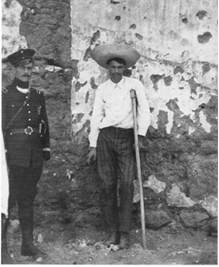106 years ago this week, El Paso was in the throngs of a race riot, state of emergency, curfew, with U.S. infantry guarding the closed border, searching houses for rioters, and controlling streets of the city. What had happened?
In a banquet honoring the victorious Constitutionalist government of Mexico over the forces of Pancho Villa on December 28, 1915, General Alvaro Obregon gave a speech to El Paso’s leaders of government, the military and commercial community. He declared the Villa faction eliminated as a threat and emphasized Constitutionalist control over Chihuahua. Important to his speech was the encouragement of mining engineers and other American businessmen to come back to Chihuahua and pick up their disrupted commerce. After all, mining, cattle ranching and farming in Chihuahua produced great profits for American entrepreneurs and equally precious income for the Mexican tax collectors along the border.
Thomas D. Edwards, US Consul in Cd. Juarez
Trusting Obregon’s guarantees, seconded by the American Consul in Cd. Juarez Thomas Edwards and the El Paso Tax Collector and intelligence agent Zach Lamar Cobb, ASARCO decided to send a group of 19 mining engineers and employees to Cusihuriachic in the mountains 100 miles to the East of Chihuahua to restart operations of the Cusi Mining Company there. The men received visas from the Mexican consul Andres Garcia and proceeded on their trip on January 10, 1916. Charles Watson, the general manager of the Cusi Mining Company had with him his dog Whiskers and $3,200 in cash (about $68,000 in today’s value) to pay outstanding salaries and wages. He declined a military escort in the hope that the train would not incur unwanted attention. That turned out to be a fateful miscalculation.
When the train pulled into the little hamlet of Santa Isabel to fill the water tanks, passengers noticed two armed men on horseback riding by the windows of the train and peering inside. Shortly thereafter they sped off. The train also continued its journey. Approximately eight kilometers from Santa Isabel, just rounding the corner of box canon, a derailed train blocked the track. When the Americans looked out, they saw heavily armed men coming down the sides of the mountain and behind the train. Thomas B. Holmes, the only American survivor described what happened next:
“Watson, after getting off, ran toward the river, Machatton [actually Richard P. McHatton of El Paso] and I followed. Machatton [sic] fell. I do not know whether he was killed then or stripped. Watson kept running, and they were still shooting at him when I turned and ran down grade, where I fell in some brush, probably 100 feet from the rear of the train. I lay there perfectly quiet and looked around and could see the Mexicans shooting in the direction in which Watson was running. I saw that they were not shooting at me, and, thinking they believed me already dead, I took a chance and crawled into some thicker bushes until I reached the bank of the stream [the Ysabel river]. I then made my way to a point probably 100 yards from the train. There I lay under the bank for half an hour and heard shoots by ones, twos [sic], and threes. I did not hear any sort of groans or yells or cries from our Americans…”
After Holmes made it back to El Paso the next day and it became clear what had happened, the city erupted into an uproar. The next day, on January 12, rescuers from El Paso with a military guard of the Constitutionalists recovered the bodies. They were badly mutilated, with multiple gun shot wounds, one victim even had his head blown off, and all but Watson were stripped of their clothes.
As the bodies arrived in El Paso on January 12, angry, white mobs started roaming the streets. In the Hotel Sheldon, the mob encountered the American Consul Edwards having a drink. They chased him down the street back to Cd. Juarez. Zach Cobb, another target of the crowd, managed to lay low. Police and city officials called for calm but the crowd increased with every hour of the day. The anger, calls for revenge and posses to hunt down the perpetrators of the murders created an explosive environment.
John J. Pershing, Commander of Ft. Bliss, 1915
Two soldiers from Fort Bliss created the spark that set off mayhem. Walking down the street in the Mexican barrio Chihuhuita got into a fight with several residents. The brawl caused more soldiers from Fort Bliss to head into town. The mob now was looking for blood. El Paso’s sheriff and police force were quickly overwhelmed. They asked General Pershing, commander of Ft. Bliss, to help. Within hours he declared a state of emergency, issued orders for curfew, and moved troops into the streets to take control of the situation. As residents of Cd. Juarez streamed across the international bridge to come to the aid of the embattled barrio residents, the military closed all crossings and isolated the barrios.
It took a whole other day to finally establish calm. Only a few people ended up arrested. Suspected Villista sympathizers, most notably Miguel Diaz de Lombardo, a longtime Mexican diplomat and Villa representative, were chased out of town. Police saved Jose Ines Salazar from a lynch mob. He spend a night in jail. The murderers of Santa Isabel got away, but not for long. Many were killed in the raid on Columbus, New Mexico two months later. The leader of the Santa Isabel massacre, Pablo Lopez was shot in both legs, caught by the Constitutionalists a few weeks later and executed in the summer of 1916.
Pablo Lopez on a crutch moments before his execution.
Listen to me on the El Paso History Radio Show with Jackson Polk and Melissa Sargent, January 15, 2022 where we discuss the Santa Isabel massacre: https://fb.watch/az0y4EoxgP/



